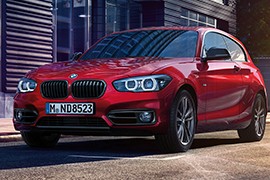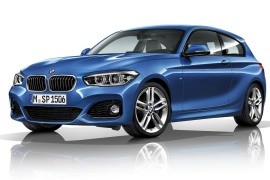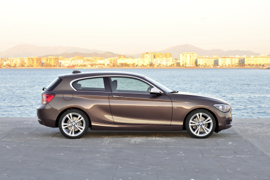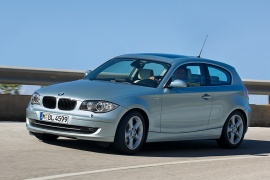BMW 1 Series 3 doors Models/Series Timeline, Specifications & Photos
First production year: 2007
Engines: Diesel, Gasoline
Body style: Hatchback
BMW introduced a final refresh for the second generation of the 1 Series in 2017, and while some updates were difficult to notice, others were significant and long-awaited by customers.
The second generation of the three-door 1 Series, known as the F21 in factory coding, was launched in 2012, almost a year after its five-door brother. Then, in 2015, the automaker introduced the facelifted version of it, or Life Cycle Impulse as the Bavarian brand called it, and customers thought that that was the end of the upgrades. However, BMW offered them a surprise in 2017 when it tweaked the look and the interior of the 1 Series 3 doors. On the engine side, there was no news, but in that department, the car was already a pleasant machine. While it wasn’t a big upgrade, like the one from 2015, it was enough to satisfy some of the demands of its customers.
The 2017 BMW 1 Series 3 doors was available with three blacked-out packages. Up front, the kidney grille was offered with a shiny black decoration that replaced the chromed one, which many considered out of style, especially on a youth-oriented vehicle. Furthermore, the automaker added black inserts into the headlights, contrasting beautifully with the LED corona lights. On the lower side of the bumper, BMW offered a standard apron with a broad but slim trapezoidal air intake flanked by a pair of scoops decorated with a horizontal slat. Those who ticked the M Sport package box received a different design, with a taller air intake flanked by rectangular-shaped side scoops that housed the fog lamps. Both versions had specially designed vents to create an air curtain around the front wheels to improve the drag coefficient.
Along with the introduction of the 2017 BMW 1 Series 3 doors, the automaker also offered two new colors: Sunset Orange and Seaside Blue. In addition, there was a choice of five new designs for the 17- and 18-inch alloy wheels, which made the car look even sportier. Thanks to the frameless windows on the long doors, the 3-door version of the 1 Series had a sportier look and was among the few to provide that feature. In the back, the available smoked taillights created a nice contrast with the LED L-shaped stripes that crossed them. Depending on the engine version, the automaker offered the car with one or two exhausts in the back. Furthermore, the M140i had a black lower trim on the bumper, which made it look even more aggressive, on par with the performance it provided.
Inside, customers found a refreshed cabin with more material options and even contrast stitching. However, the most significant upgrade was for the iDrive infotainment system. Unlike previous 1 Series models, this was available with an 8.8-inch touchscreen atop the center stack. It also had an improved layout and was moving fast. The high-bolstered seats were on the firm side, and some customers complained about them. However, these were very supportive and kept their occupants in place during high-speed cornering maneuvers. In the back, the split-folding bench seat featured three headrests, albeit there was enough room just for two adults due to the tall transmission tunnel that crossed the vehicle front to back.
Under the hood, there were no surprises. BMW offered an entry-level version powered by a 1.5-liter turbocharged three-cylinder engine. It provided just 109 PS (108 hp) and was paired exclusively with a six-speed manual. On the other hand, the base turbodiesel was available with an eight-speed automatic, thanks to its higher torque. Selected diesel and gasoline powerplants could be fitted with BMW’s xDrive intelligent all-wheel drive system.
BMW 1 Series 3 doors (F21) LCI 116d 6MT (116 HP)
BMW 1 Series 3 doors (F21) LCI 116d 8AT (116 HP)
BMW 1 Series 3 doors (F21) LCI 116d EfficientDynamics 6MT (116 HP)
BMW 1 Series 3 doors (F21) LCI 118d 6MT (150 HP)
BMW 1 Series 3 doors (F21) LCI 118d 8AT (150 HP)
BMW 1 Series 3 doors (F21) LCI 118d xDrive 6MT (150 HP)
BMW 1 Series 3 doors (F21) LCI 120d 6MT (190 HP)
BMW 1 Series 3 doors (F21) LCI 120d 8AT (190 HP)
BMW 1 Series 3 doors (F21) LCI 116i 6MT (109 HP)
BMW 1 Series 3 doors (F21) LCI 118i 6MT (136 HP)
BMW 1 Series 3 doors (F21) LCI 118i 8AT (136 HP)
BMW 1 Series 3 doors (F21) LCI 120i 6MT (184 HP)
BMW 1 Series 3 doors (F21) LCI 120i 8AT (184 HP)
BMW 1 Series 3 doors (F21) LCI 125i 8AT (224 HP)
The second generation of the 1 Series was introduced in 2011 in five-door shape, followed by its three-door brother in 2012, but both versions were restyled in 2015.
When the German car manufacturer introduced the 1 Series in 2004, it gradually expanded the range until it made an entire family of vehicles, including two hatchbacks, a coupe, and a cabriolet. For the second generation, though, it adopted a different tactic. It made the 1 Series only as a five- or a three-door hatchback, while the other versions were renamed as the 2 Series. Then, at the 2015 Geneva Motor Show, the German automaker unveiled the facelifted version of the car, also known as the LCI (Life Cycle Impulse), in BMW’s language. There were significant upgrades in all areas, and to some, it looked more like a new vehicle than just a refreshed model. Furthermore, besides the exterior and interior changes, BMW also had to replace the entire engine lineup to comply with the Euro 6 emission standards that were due to enter in September of the same year.
The front fascia was now aligned with the carmaker’s design language seen on the 3 and the 5 Series. Instead of triangular-shaped headlights pointing inwards, the 2015 BMW 1 Series 3-door featured slimmer, horizontal ones. These were also available with full-LED technology, a first for the smallest car in the automaker’s portfolio. Furthermore, the kidney grille was also reshaped and appeared slightly smaller, although with thicker chromed decorations. The lower side of the bumper had a new, narrow trapezoidal air intake in the middle flanked by scoops that could integrate the available fog lamps. Furthermore, customers could opt for an M-Sport package with an aggressive look and broader front air intakes in the apron, and also that option added a lowered ground clearance compared to the regular 1 Series models.
Since the car’s front was enhanced, BMW couldn’t leave the side of the vehicle unchanged. It couldn’t do too much, but it did emphasize the ascending creased line that started from the front fenders. It ran along the bodywork, over the new door handles, and all the way to the rear quarter panels. Base versions came fitted with standard 16-inch alloy wheels with an option for 17-inch ones. At the same time, the top performer of the family, the M140i, was riding on 18-inch wheels. Unlike its five-door sibling, the three-door version had longer doors without frames for the windows, which made it look sportier. Finally, at the back, the automaker installed fresh LED taillights extended from the rear fenders onto the tailgate with L-shaped stripes.
The 2015 BMW 1 Series 3-door came with a dramatically enhanced cabin. Atop the center stack, the automaker installed a 6.5-inch color display for the new NBT infotainment system, which used 3G connectivity to go over the Internet for traffic alerts and customer support. Those wishing for more could opt for the 8.8-inch color display, which also came with enhanced functions for the entire system. The automaker installed bolstered seats at the front that could tilt forward and move to allow access for those on the bench seat. Since the car’s wheelbase was the same as on the non-facelifted version, the knee room was identical. However, customers who opted for this bodywork version were less concerned about the rear seats and more about the driving experience.
For that matter, the automaker ditched the entire N-family of engines and replaced it with the more robust and better B-family one. Even though these two shared some bits and pieces, there were significant improvements, especially for the inline-four and inline-six versions. While the entry-level version was powered by an inline-three powerplant, the top-spec version was the mighty M140i that sent 340 PS (335 hp) to the rear or in all corners, depending on the option. Besides the 116i, the 118i, and the 116d versions, all models could be fitted with BMW’s xDrive AWD system.
BMW 1 Series 3 doors LCI (F21) 116d 6MT RWD (116 HP)
BMW 1 Series 3 doors LCI (F21) 116d 8AT RWD (116 HP)
BMW 1 Series 3 doors LCI (F21) 116d Efficient Dinamics RWD 6MT (116 HP)
BMW 1 Series 3 doors LCI (F21) 118d 6MT RWD (150 HP)
BMW 1 Series 3 doors LCI (F21) 118d 8AT RWD (150 HP)
BMW 1 Series 3 doors LCI (F21) 118d xDrive 6MT AWD (150 HP)
BMW 1 Series 3 doors LCI (F21) 120d 6MT RWD (190 HP)
BMW 1 Series 3 doors LCI (F21) 120d 8AT RWD (190 HP)
BMW 1 Series 3 doors LCI (F21) 116i 6MT RWD (109 HP)
BMW 1 Series 3 doors LCI (F21) 118i 6MT RWD (136 HP)
BMW 1 Series 3 doors LCI (F21) 118i 8AT RWD (136 HP)
BMW 1 Series 3 doors LCI (F21) 120i 6MT RWD (177 HP)
BMW 1 Series 3 doors LCI (F21) 120i 8AT RWD (177 HP)
BMW 1 Series 3 doors LCI (F21) 125i 6MT RWD (218 HP)
BMW 1 Series 3 doors LCI (F21) 125i 8AT RWD (218 HP)
BMW 1 Series 3 doors LCI (F21) M135i 6MT RWD (326 HP)
BMW 1 Series 3 doors LCI (F21) M135i 8AT RWD (326 HP)
BMW 1 Series 3 doors LCI (F21) M135i xDrive 8AT AWD (326 HP)
BMW 1 Series 3 doors LCI (F21) M140i 6MT RWD (340 HP)
BMW 1 Series 3 doors LCI (F21) M140i 8AT RWD (340 HP)
BMW 1 Series 3 doors LCI (F21) M140i xDrive 8AT AWD (340 HP)
After the introduction of the second generation of the 1 Series in a five-door shape, known as the F20 in factory coding, in 2011, the automaker expanded the range with a three-door version in the following year.
Launched at the Auto Mobil International Leipzig 2012, the new hatchback-styled three-door vehicle from the German automaker was expected by those customers who wanted to get their hands on a more affordable Bimmer and still get the similar pleasure of driving as those aiming at the 3 Series. Furthermore, since the car was shorter, it was better suited for city driving. BMW developed the 1 Series on the same L7 platform as the 3 and 4 Series. This approach helped the automaker lower production costs and also improved some of the downturns of the previous generation of the 1 Series. Thanks to the longer wheelbase (plus 30 mm or 1.2 inches), the rear seats were no longer redundant for adult-sized passengers, and even the trunk was larger. Last but not least, the car benefited from improved engines and, most importantly, a fresh automatic gearbox.
The car was penned after Chris Bangle left the German automaker’s styling department, and the new look was credited to Nicolas Huet. He created a new front fascia that sported triangular-shaped horizontal headlights pointing inward. They featured the already-known corona lights for the DRLs. They flanked the enlarged kidney grille that dominated the front side of the vehicle. Lower, on the bumper, the automaker added a broad air intake that sported round fog lamps on the sides.
From its profile, the 2012 BMW 1 Series 3 door kept the same shape and wheelbase as its five-door sibling. Unlike that, it carried over the idea from the previous generation with the frameless windows and the longer doors that eased access to the rear seats as well. To emphasize the car’s sporty character, BMW sloped down the upper section of the rear windows, like in a coupe, despite the car being a hatchback. However, it kept the famous Hofmeister kick, which was a signature design feature for the entire BMW range since the early 70s. At the back, the tailgate featured a tilted forward window adorned at the top by a roof spoiler. Like its predecessor, the second generation of the 1 Series had corner-mounted taillights. When customers ordered the car with the optional Xenon headlights, they automatically got the L-shaped LED banks for the taillights.
Like most BMWs from those times, the cockpit was driver-oriented. Fronting them was a minimalist-looking instrument cluster filled with the large dials for the speedometer and the rev counter, plus the fuel level gauge. Any other information could be accessed via the car’s standard onboard computer on the screen mounted underneath the main dials. Furthermore, BMW offered the iDrive infotainment system as standard across the range, fitted with a 6.5- or 8.8-inch screen atop the center stack that could show any essential information about the vehicle’s status. As expected, the best seats in the house were at the front, albeit in standard shape, and they were barely bolstered and supportive on the sides. In the back, thanks to the increased wheelbase, customers gained an additional 21 mm (0.8-inch) of knee room. Unfortunately, the tall transmission tunnel still affected legroom.
The 2012 BMW 1 Series three-door was based on a front-engine and rear-wheel drive platform carried over from its bigger sibling, the 3 Series. That meant that it was also available with an all-wheel drive system for specific versions, which was more than welcomed by customers. Another crucial update was the introduction of the eight-speed automatic gearbox that improved fuel efficiency.
BMW 1 Series 3 doors (F21) 114d 6MT RWD (95 HP)
BMW 1 Series 3 doors (F21) 116d 6MT EfficientDynamics RWD (114 HP)
BMW 1 Series 3 doors (F21) 116d 6MT RWD (116 HP)
BMW 1 Series 3 doors (F21) 116d 8AT RWD (116 HP)
BMW 1 Series 3 doors (F21) 118d 6MT RWD (143 HP)
BMW 1 Series 3 doors (F21) 118d 8AT RWD (143 HP)
BMW 1 Series 3 doors (F21) 118d xDrive 6MT AWD (143 HP)
BMW 1 Series 3 doors (F21) 120d 6MT RWD (184 HP)
BMW 1 Series 3 doors (F21) 120d 8AT RWD (184 HP)
BMW 1 Series 3 doors (F21) 120d xDrive 8AT AWD (184 HP)
BMW 1 Series 3 doors (F21) 114i 6MT RWD (101 HP)
BMW 1 Series 3 doors (F21) 116i 6MT RWD (136 HP)
BMW 1 Series 3 doors (F21) 116i 8AT RWD (136 HP)
BMW 1 Series 3 doors (F21) 118i 6MT RWD (170 HP)
BMW 1 Series 3 doors (F21) 118i 8AT RWD (170 HP)
BMW 1 Series 3 doors (F21) 125i 6MT RWD (214 HP)
BMW 1 Series 3 doors (F21) M135i 6MT RWD (320 HP)
Less than three years after the introduction of the 1 Series’ first generation, BMW unveiled the facelift for this compact hatchback in a three-door shape at the 2007 Geneva Motor Show.
Sales for the first generation of the five-door version of the 1 Series (E87 in factory coding) looked promising. In its first three years, the five-door hatchback exceeded the 3 Series compact (E36) sales in its seven-year production run. Then, BMW decided to launch the three-door version of its entry-level range, bumping the sales, also known as the E81 in factory coding. Thanks to this new version, sales jumped over the barrier of 200,000 units in the following years despite the world financial crisis that followed. The refreshed version, or Life Cycle Impulse (LCI) as BMW liked to call it, was unveiled in March 2007 in Switzerland, with sales for the three-door model starting in May of the same year.
Up front, the three-door 1 Series came with the refreshed front fascia for the entire range, featuring xenon headlights and clear covers for the twin-headlamp unit. There were small differences between the facelifted and the non-facelifted version of the car. But a keen eye for detail could spot them on the kidney grille, which featured rounded upper outer corners instead of sharp ones. Furthermore, the lower bumper was new and had a broad air intake that ran along the entire width of the apron, integrating the available rectangular fog lamps. Previously, these were rounded and flanked the center-mounted air intake.
The car’s profile appeared similar to the five-door version, albeit with two fewer doors. However, the E81 seemed sportier thanks to its longer doors with frameless windows. Furthermore, the rear side windows were shorter and arched down to amplify the car's dynamic look. Another detail that came along with the facelifted version of the range was the side crease that crossed the vehicle front to back, which visually connected the front fenders to the taillights. Out back, the slightly tilted forward rear window of the tailgate was adorned at the top by a roof spoiler. The taillights were also redesigned and had two clear lenses, one for the reversing lights and the other for the turn signals. As a last detail, the rear bumper was smoother since it didn’t have a sculptured line from side to side.
The car’s interior was new, featuring a redesigned steering wheel and silver decorations on the lower spoke. In addition, the dashboard also sported new materials and the available swing-up screen for the iDrive infotainment system. Customers were greeted by high-bolstered seats at the front that could be tilted forward to allow access to the rear bench seat. BMW noticed that even in the five-door bodywork, there was limited legroom for those seated there. As a result, the three-door version looked like a proper approach to the segment. It even offered a four-seat layout where the rear bench seat was profiled for two and featured a center storage compartment. The trunk space was large enough for weekly shopping and a holiday in two but not large enough to accommodate the luggage for a family of four.
On the engineering side, the refreshed version of the 1 Series came with improved engines that provided more power than the 2004 model year. Furthermore, these updated powerplants were made to be quickly adapted to the Euro 5 emission standards due to be entered in 2009. Most versions were available with a six-speed manual or a six-speed automatic, which transformed the shortest BMW into an excellent city cruiser.
BMW 1 Series 3 doors (E81) 116d 6MT RWD (115 HP)
BMW 1 Series 3 doors (E81) 118d 6AT RWD (143 HP)
BMW 1 Series 3 doors (E81) 118d 6MT RWD (143 HP)
BMW 1 Series 3 doors (E81) 120d 6AT RWD (177 HP)
BMW 1 Series 3 doors (E81) 120d 6MT RWD (177 HP)
BMW 1 Series 3 doors (E81) 116i 6AT RWD (122 HP)
BMW 1 Series 3 doors (E81) 116i 6MT RWD (122 HP)
BMW 1 Series 3 doors (E81) 118i 6AT RWD (143 HP)
BMW 1 Series 3 doors (E81) 118i 6MT RWD (143 HP)
BMW 1 Series 3 doors (E81) 120i 6AT RWD (170 HP)
BMW 1 Series 3 doors (E81) 120i 6MT RWD (170 HP)



